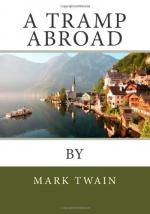About 6 P.M., we arrived at the snow upon the ridge descending toward Zermatt, and all peril was over. We frequently looked, but in vain, for traces of our unfortunate companions; we bent over the ridge and cried to them, but no sound returned. Convinced at last that they were neither within sight nor hearing, we ceased from our useless efforts; and, too cast down for speech, silently gathered up our things, and the little effects of those who were lost, and then completed the descent.
----------
Such is Mr. Whymper’s graphic and thrilling narrative. Zermatt gossip darkly hints that the elder Taugwalder cut the rope, when the accident occurred, in order to preserve himself from being dragged into the abyss; but Mr. Whymper says that the ends of the rope showed no evidence of cutting, but only of breaking. He adds that if Taugwalder had had the disposition to cut the rope, he would not have had time to do it, the accident was so sudden and unexpected.
Lord Douglas’ body has never been found. It probably lodged upon some inaccessible shelf in the face of the mighty precipice. Lord Douglas was a youth of nineteen. The three other victims fell nearly four thousand feet, and their bodies lay together upon the glacier when found by Mr. Whymper and the other searchers the next morning. Their graves are beside the little church in Zermatt.
CHAPTER XLII [Chillon has a Nice, Roomy Dungeon]
Switzerland is simply a large, humpy, solid rock, with a thin skin of grass stretched over it. Consequently, they do not dig graves, they blast them out with power and fuse. They cannot afford to have large graveyards, the grass skin is too circumscribed and too valuable. It is all required for the support of the living.
The graveyard in Zermatt occupies only about one-eighth of an acre. The graves are sunk in the living rock, and are very permanent; but occupation of them is only temporary; the occupant can only stay till his grave is needed by a later subject, he is removed, then, for they do not bury one body on top of another. As I understand it, a family owns a grave, just as it owns a house. A man dies and leaves his house to his son—and at the same time, this dead father succeeds to his own father’s grave. He moves out of the house and into the grave, and his predecessor moves out of the grave and into the cellar of the chapel. I saw a black box lying in the churchyard, with skull and cross-bones painted on it, and was told that this was used in transferring remains to the cellar.
In that cellar the bones and skulls of several hundred of former citizens were compactly corded up. They made a pile eighteen feet long, seven feet high, and eight feet wide. I was told that in some of the receptacles of this kind in the Swiss villages, the skulls were all marked, and if a man wished to find the skulls of his ancestors for several generations back, he could do it by these marks, preserved in the family records.




